Breastfeeding position: What is the right way to breastfeed?
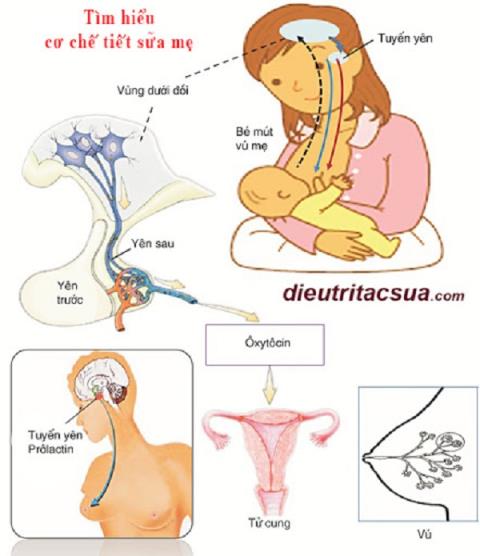
“Breast milk is the best food for the comprehensive development of infants and young children.” Breast milk is a special secretion of love. Breast milk brings great benefits not only to the baby and mother, but also to the father, family and society. When starting to have milk, most mothers always wonder how to breastfeed, how to breastfeed properly, how to successfully breastfeed, especially for mothers who have given birth. first child. This article will answer all these questions.
content
- 1. How is breast milk secreted when breastfeeding?
- 2. Principles of breastfeeding
- 3. The positions of holding the baby
- 4. How to properly latch on to the breast
- Summary
1. How is breast milk secreted when breastfeeding?
The simple mechanism of breast milk secretion is summarized in the following figure:
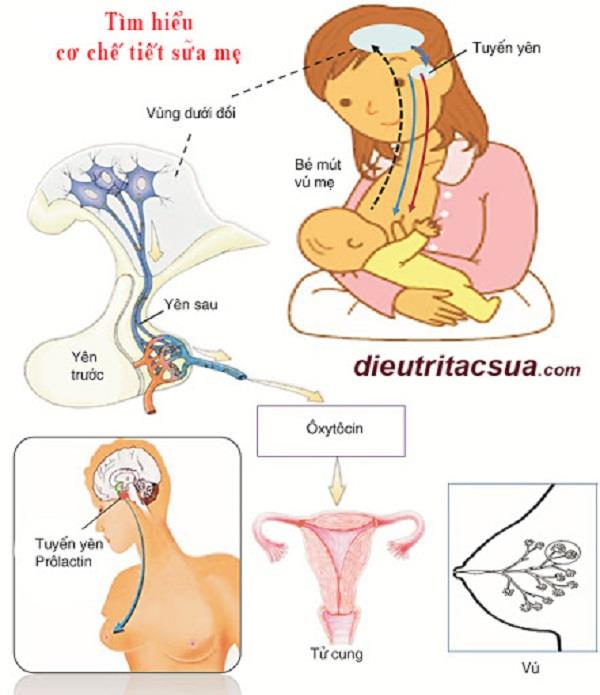
Mother's milk secretion mechanism
When the baby latches on to the mother's breast, the receptors in the breast are stimulated to do:
- About 5 minutes after the baby starts suckling, the post-pituitary gland secretes Oxytocin, which causes the milk that has been produced to flow down the nipple. At the same time, Prolactin has the effect of causing uterine contractions to help mothers reduce pain, reduce blood loss and sleep better, heal faster.
- About 30 minutes after the baby starts suckling, the hypothalamus secretes Prolactin Releasing Hormone (PRH) to the pituitary before it secretes Prolactin. Prolactin stimulates mammary glands to produce milk for the next feeding.
Thus, the more the baby sucks on the breast, the more milk is produced and flows down. On the contrary, if the baby does not plug, milk will not be produced. Mothers need to suckle their baby even though they don't feel engorged, to stimulate milk production and let-down.
2. Principles of breastfeeding
- Breastfeed as soon as possible within the first 60 minutes.
- Breastfeed your baby on demand.
- Do not use a pacifier .
- Empty at least one breast in a feeding.
- Breastfeeding with correct technique.
- Keep up the good spirits and eat well.
2.1. Why should the baby breastfeed as soon as possible?
Colostrum is formed in the last months of pregnancy. Right at birth and the process of removing the placenta from the mother's uterus causes hormonal changes. Prolactin is formed to push colostrum out. Within the first 60 minutes after birth, mothers should breastfeed their babies.
Colostrum, although very small, only about 15ml in the first 24 hours, has many antibodies and is very concentrated. This amount of milk provides enough energy for the baby. Give your baby a pacifier without expressing to see if there is any milk in the breast. After giving birth, the mother just lies down to rest. Family members or medical staff will help the baby latch on to the breast without the mother having to hold the baby.

Need to breastfeed immediately to provide nutritious colostrum
2.2. Why breastfeed on demand?
Mothers should give the baby a nipple every time the baby is hungry without feeling the breast stretch. Because at that time, the mother's breasts already have milk created from the previous feeding. Do not call your baby to feed if he is not really hungry. During the first month after birth, most of the baby's time is spent sleeping. Healthy full-term babies can sleep up to 4 hours long. After 4 hours, if the baby does not wake up, it should be woken up to breastfeed. If the baby is sick or preterm, low weight, the interval between feedings will be closer.
2.3. Why is it important to dry at least one breast in one feeding?
Breastfeeding a baby will help to increase milk well. Because when the milk is completely exhausted, the mother's body produces the most prolactin. If milk remains after feeding inhibiting Prolactin secretion, milk production gradually decreases. This also avoids blockage of milk, which can cause mastitis or breast abscess if the blockage is more severe.
In addition, feeding your baby dry on at least one breast allows the baby to take advantage of all the nutrients from the mother's milk. During single breast feeding, in the first 5 minutes without oxytocin, breast milk is mainly high in water, sugar and protein and low in fat. After having Oxytocin, the fat in the milk will gradually increase, so the milk also has more energy.
If your baby is still crying after feeding from one breast, offer the other breast.
If the baby has not finished breastfeeding but is full, mothers should express the remaining milk and store it cold. After a few days, the mother will know the baby's need to suckle. In later feedings, you can express some colostrum to give your baby more energy to suckle.
>> Mothers can refer to: How to prepare and store breast milk for babies?

Choose the right breastfeeding position so that your baby gets the nutrients he needs
2.4. What is the correct breastfeeding technique?
There are many different breastfeeding positions, but it is necessary to ensure the following principles, including:
Correct breastfeeding position:
- Mother and child in the most comfortable position.
- Keep the baby's head in line with the baby's body.
- Support the baby's entire body.
- The baby's belly is close to the mother's body.
- The baby's face is opposite the breast, the baby's mouth is opposite the nipple.
Correct sucking on the breast:
- Chin touches mother's breast.
- Mouth wide open.
- The lower lip is brought out.
- The areola is seen more above than below.
Effective suckling:
- Feed slowly, deeply, with occasional breaks.
- Automatically discard breast when full.
- Feeding time is about 15 ± 5 minutes.
- After feeding, sleep for 2-4 hours.
- Gain enough weight (20-30g/day). Note: Physiological weight loss: ≤ 7% in term infants and ≤ 10% in preterm infants.
2.5. Why shouldn't a pacifier be used?
Breastfeeding with a pacifier can make your baby more susceptible to infections and can deform the jaw. There is a big difference in how the pacifier and mother's breast are attached.
- When sucking a pacifier, the baby latches on easily, without a button, the milk still flows and the baby is full quickly. In some cases, mothers continue to breastfeed when the baby is full, increasing the risk of gastroesophageal reflux.
- When breastfeeding, the baby has to open his mouth wide to suck on the areola and must suck the nipple to get the milk out. Children have to work a lot harder.
Therefore, babies who have used a pacifier or criticized the mother's breast. This is a common cause of breastfeeding failure and many mothers have to pump milk to breastfeed.

A pacifier should not be given because babies tend to criticize the mother's breast
2.6. Stay happy, optimistic and eat well
- After giving birth, mothers have many problems to worry about. Stress reduces lactation. The problem of "postpartum depression" must have been heard by many of us, even experienced. Mothers are often in a tired and sad mood, so fathers and families need to share and support them both physically and mentally.
- Currently, some families still have the old concept that after giving birth, they must stay at home and eat only certain foods. During this period, the mother needs to be provided with a lot of energy with a full range of nutrients. Abstinence makes mothers undernourished, more tired and stressed.
3. The positions of holding the baby
3.1. Holding position
This is the most common position. Place your baby's back on your forearm, baby's head at the bend of the elbow, and use your hand to support the baby's bottom. The mother's other hand to lift the breast. By turning the forearm, the mother can easily direct the baby's whole body towards her. The baby's mouth should be at breast level. Place your baby's arms on either side of the breast to feed. Only the back arm can hug the mother's hand. A pillow can be used to support the baby's body and one arm of the mother.
Common mistake: baby is lying on his back on his forearm, with his head turned towards the mother. The baby cannot breastfeed in this crooked position. It is necessary to correct the position of the forearm so that the baby's body is close to the mother's body, the abdomen is against the abdomen.
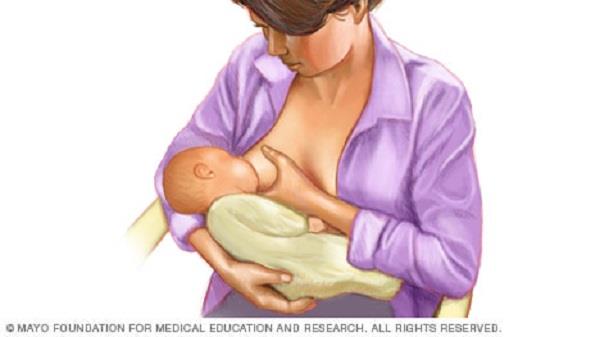
Breastfeeding and holding position
2.2. Cross pose
The crossed position is similar to the holding position, except that the mother's hands change roles. In the crossed position, the baby is supported by the hand and forearm opposite the nursing breast.
This position helps mothers better control the baby's head when the head is placed between the fingers and hands. This breastfeeding position is great for babies who are very small or have difficulty latching onto the breast. The mother's hand can be easily fixed to the correct position of the baby's head.
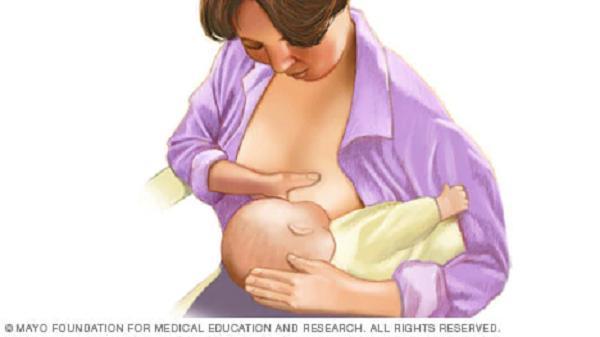
Crossing breastfeeding position
2.3. Tight couple pose
She sat up straight, leaning against a chair or wall. Shoulders are straight and comfortable. Hands and fingers support baby's shoulders, neck and head. The baby's face is facing up close to the mother's chest. The baby's upper back rests on the forearm. Baby's feet lean behind. The baby's bottom is at the level of the mother's elbow. Place the pillow under the mother's arm for comfort, and at the same time raise the baby at breast level. The other hand is used to raise the nipple.
The advantage of this breastfeeding position is that the mother can observe the baby sucking and control the position of the baby's head. This position is often used for mothers who have had a caesarean section , low birth weight or premature babies, twins, large breasts or flat nipples, or children who have difficulty latching onto the breast.
2.4. Lying position
It is not necessary for a mother to always sit while breastfeeding. Breastfeeding is possible in the lying position. Mother lying on her side, head high. Pillows can be placed on the back and thighs. Legs bent at the knee. Try to keep your back and hips in line. Place the baby on his side, with his face close to the mother's lower chest. The baby's mouth is at the level of the nipple. Use your lower arm to hug and hold your baby. The other arm is used to lift the breast. You can change positions to feed your baby from the other breast. In case you don't want to change your breastfeeding position, put a high pillow underneath to raise the baby's whole body up.
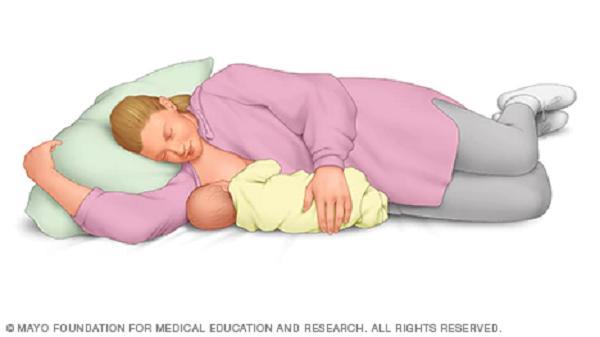
You can also breastfeed while lying down
This position is suitable for cases of caesarean section, night feeding or when the mother is tired.
In order for the mother and the baby to be in the most comfortable position, the mother does not have to bend her back to hug her baby, she can put a pillow under the baby's body. The pillow has the effect of lifting the baby's body up and is completely smooth and comfortable.
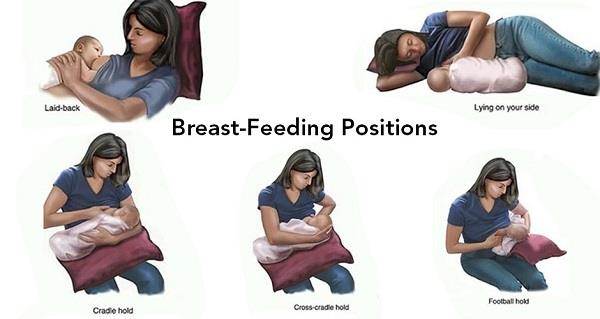
Summary of some breastfeeding positions you can refer to
4. How to properly latch on to the breast
After ensuring the correct breastfeeding position, correct latching is a very important step.
Procedure for placing the baby on the mother's breast
- Bring your baby's lips close to your nipple. Your baby will respond by opening his mouth wide and pushing his tongue out.
- The mother lifts the breast with her hand, holding the breast so that the nipple is straightened or slightly raised.
- The mother brings the baby closer to her, helps the baby recognize the breast and latch on to the nipple and areola as much as possible.
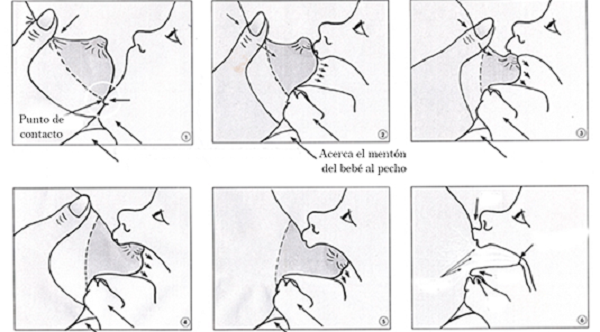
Steps to get your baby to suck on a pacifier
The milk-filled sinuses are located in the areola, not the nipple. Correct sucking, the baby will latch on to the entire areola, so effectively squeeze the milk sinuses. A well emptied udder will help your baby get milk.
When latching on to the wrong breast, the baby only latches on to the breast without squeezing the milk sinuses. As a result, the baby has to spend a lot of work to suck the milk but the milk comes out very little. Many times like that, the baby will get tired of sucking at the breast.
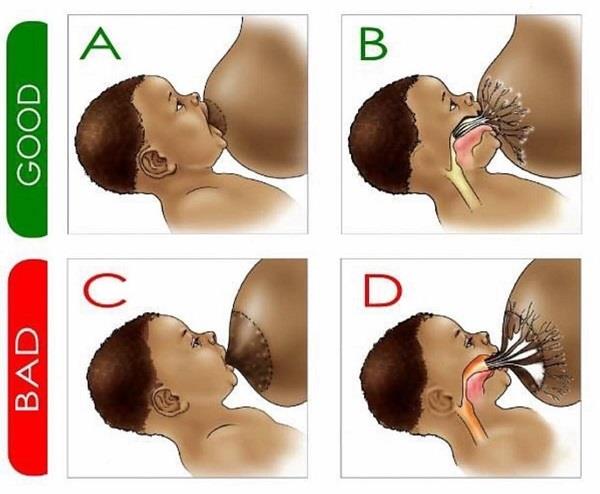
How to breastfeed right and wrong
Note that all mothers can have enough milk to feed twins if they know how to breastfeed properly. There is no limit to the time it takes to restore breast milk, as long as the mother really wants it. Working mothers can express milk regularly every 3 hours, store it and bring it home to feed the baby when the mother is away.
Summary
In fact, the rate of exclusive breastfeeding in the first 6 months in Vietnam is very low compared to the world average (19.6% vs. 35% according to 2011 statistics). Most mothers think that they do not have enough milk, so they will supplement formula milk for their babies. However, the cause could be the incorrect way the mother breastfeeds, which limits milk production. Mothers need detailed counseling to be able to breastfeed successfully. This article hopes to provide some basic knowledge about breastfeeding positions, how to breastfeed successfully.